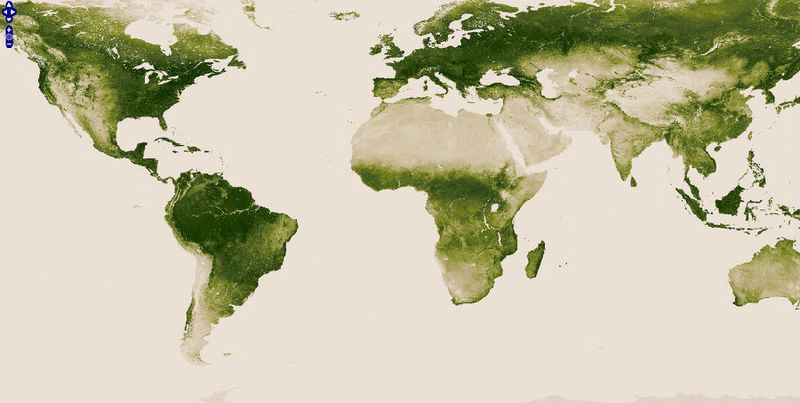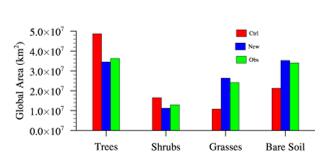Development of a New Establishment Scheme and Its Validation for a Dynamic Global Vegetation Model
Date:2016-04-26
In nature, the well-known process that includes seed production, propagation, storage, and the establishment of saplings, is a uniquely effective way to reproduce for most trees and shrubs, and it plays a key role in community structure and transitions. Such a process is usually influenced by certain abiotic factors, such as light, temperature, and soil water.

Global vegetation distribution (Credit: NOAA, http://www.nnvl.noaa.gov/green.php )
In Dynamic Global Vegetation Models (DGVMs), the establishment module mainly refers to flowering, fertilization, seed production and germination, as well as the growth of tree seedlings. However, due to the complexity of recruitment processes and a lack of observational data, current establishment schemes usually simplify and modify recruitment processes based on ecological mechanisms. For example, climate and/or environmental factors are often introduced into models as physiological thresholds and are not directly related to forest dynamics. Such simplifications may lead to simulation biases in forest ecosystem dynamics and responses of vegetation to climate change.
In a study recently accepted by Advances in Atmospheric Sciences, a new establishment scheme for introducing soil water as a function – rather than a threshold – was developed and validated, using version 1.0 of IAP-DGVM1.0 as a test bed. Compared with the original scheme, the new scheme significantly improved simulations of tree population density, especially in the peripheral area of forests and transition zones. Consequently, biases in forest fractional coverage were reduced in approximately 78.8% of the global grid cells. The global simulated areas of tree, shrub, grass and bare soil performed better, where the relative biases were reduced from 34.3% to 4.8%, from 27.6% to 13.1%, from 55.2% to 9.2%, and from 37.6% to 3.6%, respectively (Fig. 1). Furthermore, the global distribution of dominant plant functional types was described more correctly in the new scheme simulation.

Fig. 1. Global area of trees, shrubs, grasses and bare soil calculated from the original scheme (Ctrl), new scheme (New), and CLM4.0 surface data (Obs). (Song et al., 2016)
Citation: Song, X., X. Zeng, J. Zhu, and P. Shao, 2016: Development of an establishment scheme for a DGVM. Adv. Atmos. Sci., doi: 10.1007/s00376-016-5284-y. (in press)
Contact: SONG Xiang, songxiang@mail.iap.ac.cn
